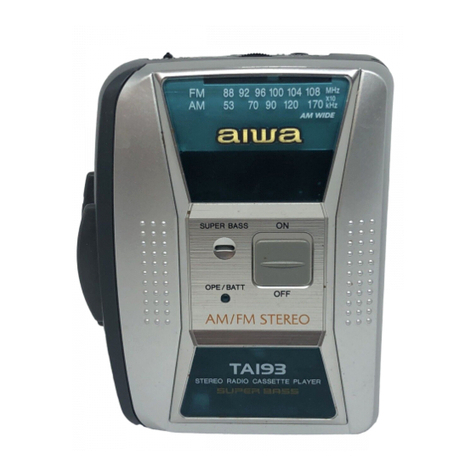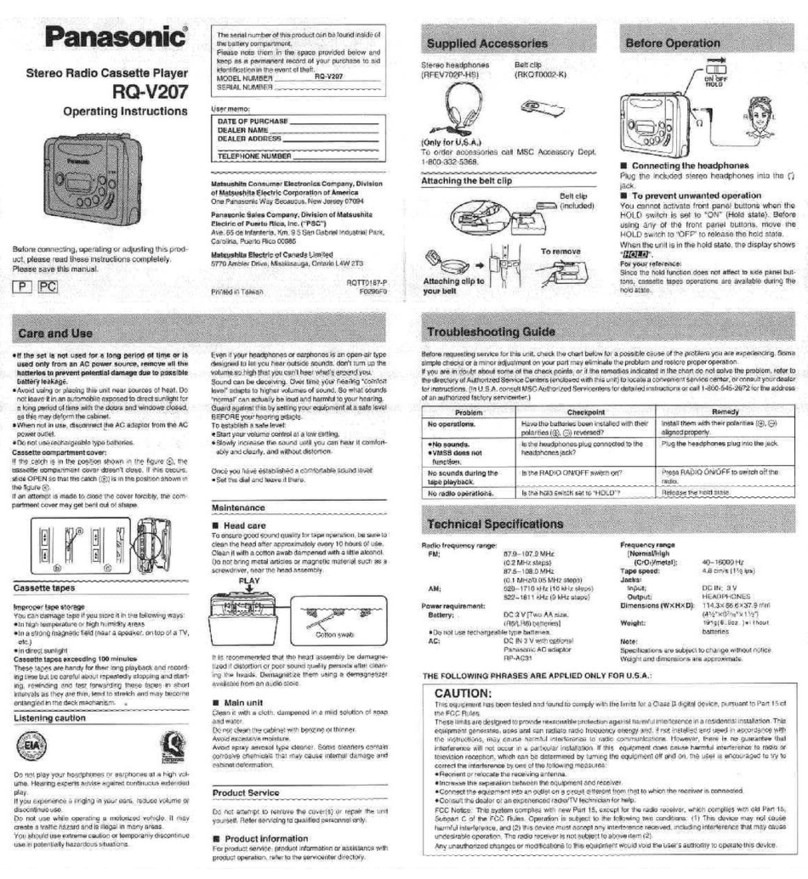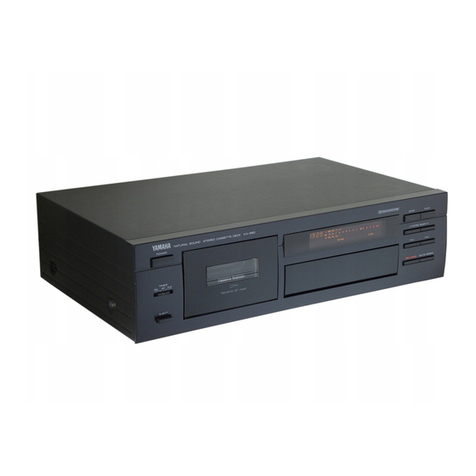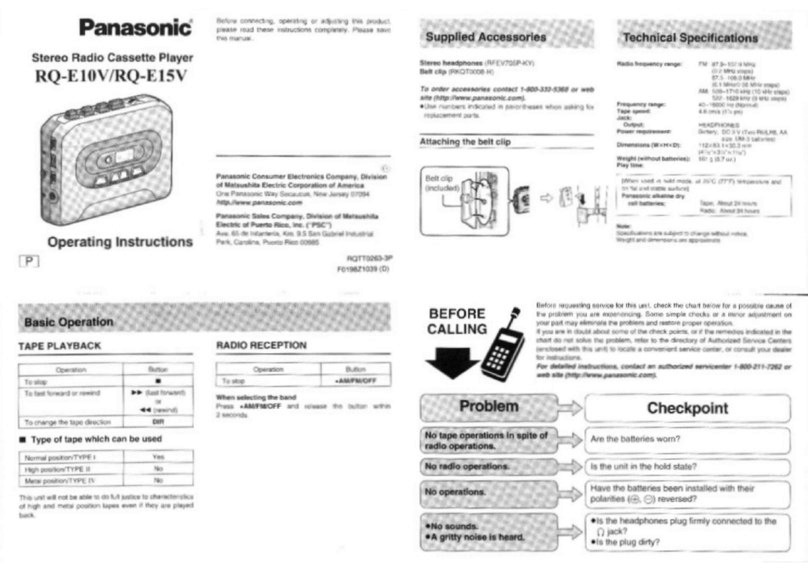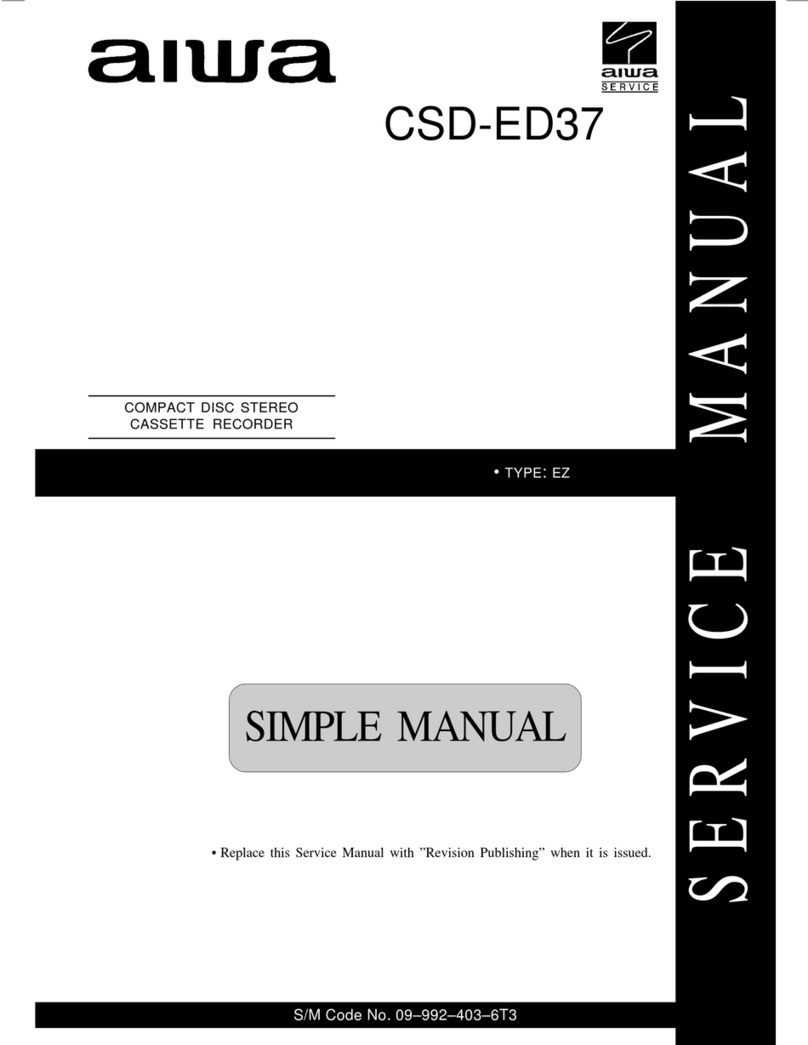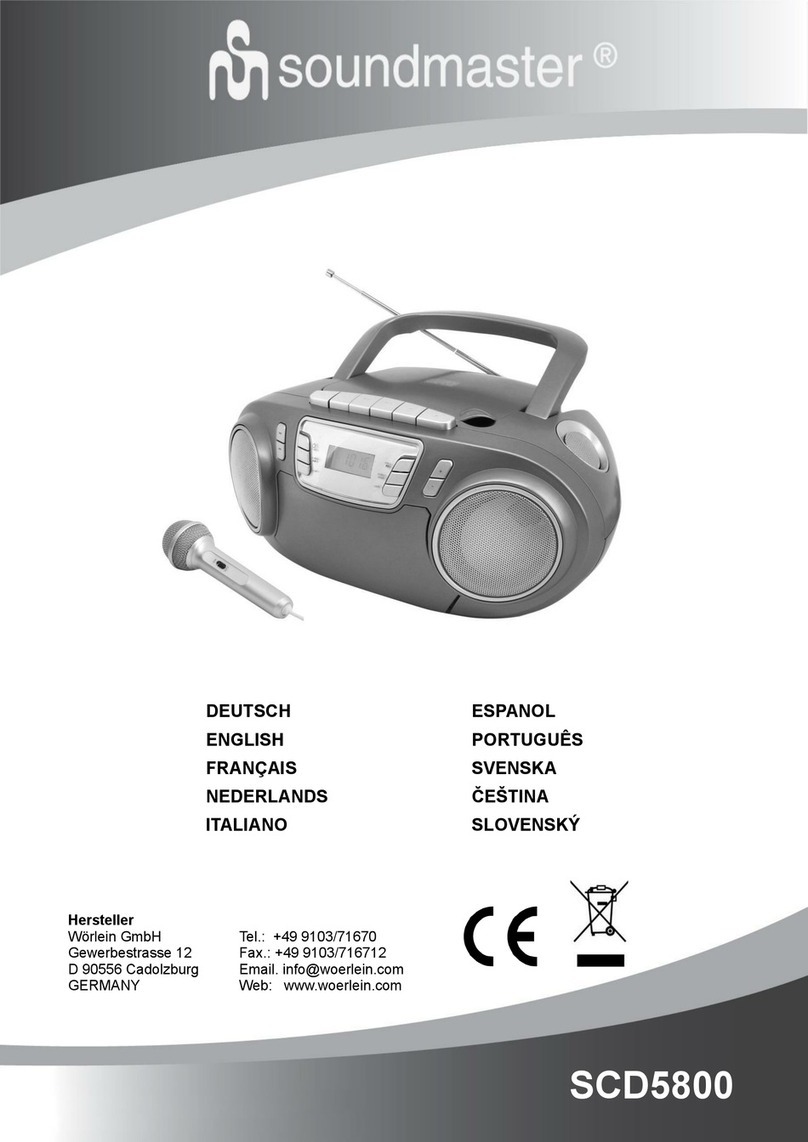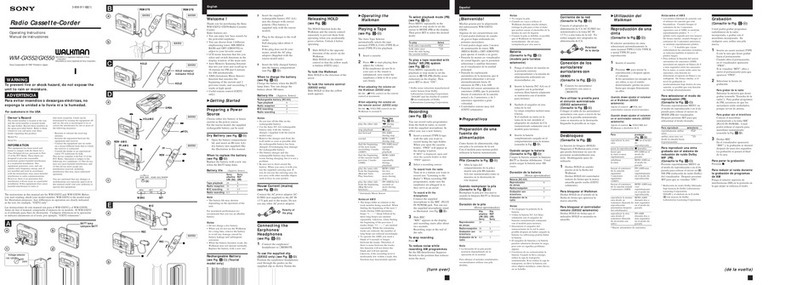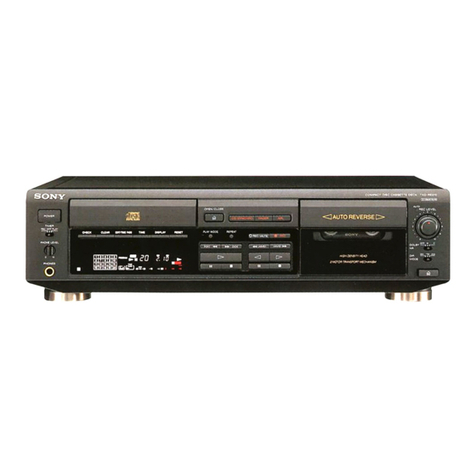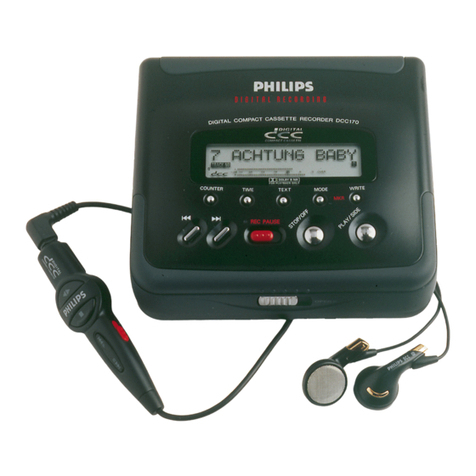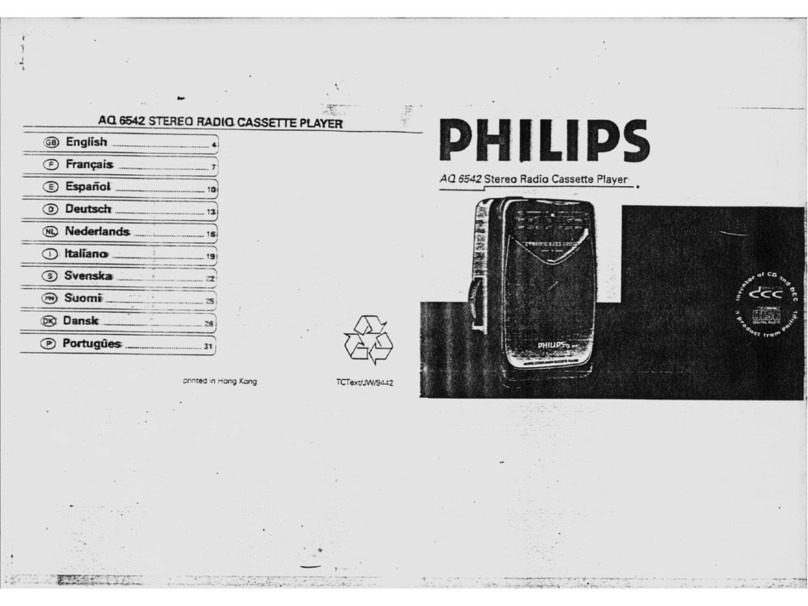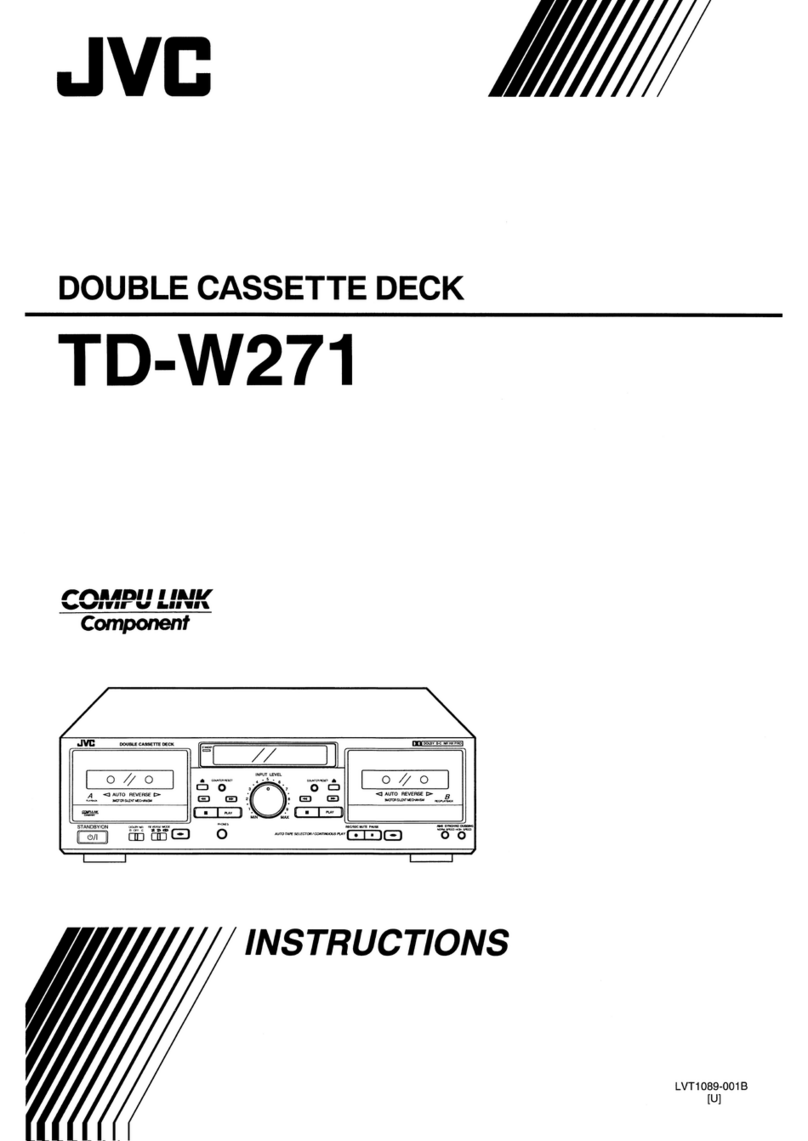Bergstrom G777 User manual

•BRING BACK HAPPY MEMORIES BY PLAYING ALL
OF YOUR FAVOURITE CASSETTES
•SMALL AND PORTABLE SO YOU CAN TAKE
ANYWHERE
•RECORDING FUNCTION SO YOU COULD RECORD
YOURSELF AND FAMILY TALKING AS YOU CREATE
NEW MEMORIES, AS WELL AS RECORDING
REMINDERS, NOTES ETC
•FIVE CASSETTE KEYS; PLAY, FORWARD, BACK, STOP

AND RECORD
•BUILT IN SPEAKER
•REMOVABLE BELT CLIP
•AUTO STOP MECHANISM
•3.5MM PHONE JACK
•3v DC IN-JACK (CABLE NOT INCLUDED)
•HEADPHONES INCLUDED
•USES 2XAA BATTERIES (Not included)
ASSEMBLY INSTRUCTIONS / INSTRUCTIONS FOR USE:
Unpack the components carefully. Please check all parts
have been removed from the packaging.
Important!
Before using your Personal Cassette Playerand

Recorder for the first time, please take the time to read
these instructions carefully.
The Personal Cassette Player is intended for
indoor, domestic use only. It should not be used
for commercial applications.
This appliance contains no user serviceable parts.
All repairs must be carried out by a qualified
person. Incorrect repairs may place the user at
risk of harm, and will invalidate any guarantee.
Do not operate this appliance after it has
malfunctioned, or if it has been dropped or
damaged in any way.
Do not expose to dripping or splashing.
Never place any heavy objects, or any containers
filled with liquid on top of the Personal Cassette
Player.
Do not leave the Personal Cassette Playernear
heat sources, or in direct sunlight, or anywhere
that is excessively dusty, sandy or humid.
Never insert any foreign objects into any of the
outlets on the Personal Cassette Player.
The Personal Cassette Playeris not a toy. It

shouldonly be used by children more than eight
years of age.
The Personal Cassette Playershould not be used
by anyone with reduced physical, sensory or
mental capabilities,unless they have been given
supervision or instruction on how to use it safely.
Getting to know your Personal Cassette Player
LOCATION OF CONTROLS

Powering your Personal Cassette Player/Recorder
The Personal Cassette Player and Recorder is powered
with either two AA (UM-3) batteries or an AC/DC
adaptor. Please note: Both the batteries or AC/DC
adaptor are not supplied.
IMPORTANT!
Only use an AC/DC adaptor with an output voltage rated
as 3V DC, 300mA, with a centre negative plug (Not
Included)
Using batteries (NOT SUPPLIED)
1. Open the Battery Compartment (10) on the back
of the unit by sliding open and gently pulling
upwards the battery door.
2. Check the polarity (+/-) inside the battery
compartment.
3. Insert two AA (UM-3) batteries according to the
polarity.

4. Close the battery door.
For best performance and extended operating time, we
recommend using alkaline batteries.
IMPORTANT!
Please always ensure batteries are correctly
installed. Incorrect polarity can damage your
Personal Cassette Player and Recorder.
Never mix old and new batteries.
Never mix alkaline, standard (carbon-zinc) and
rechargeable (nickel-cadmium) batteries.
If you are not planning to use your Personal
Cassette Player for an extended period of time,
always remove the batteries. Old or leaking
batteries can cause damage to the unit.
Never dispose of batteries in a fire - batteries can
leak or explode.
Using an AC/DC adaptor (NOT SUPPLIED) - Only use an
3VDC, 300mA adaptor
1. Insert the DC plug (at the end of the AC adaptor
cord) into the DC Jack (9) on the side of the unit.

2. Plug the AC adaptor into a 230V~ 50Hz AC power
socket.
3. The Personal Cassette Player will automatically
disconnect from using battery power and operate
using the AC/DC adaptor.
Always switch OFF before disconnecting and
unplugging the adaptor when not in use.
Playing cassette tape
1. Insert the provided Earphones plug into the Phone
Jack (12).
2. Put on the Earphones.
3. Open the Cassette Door (1) and insert a pre-
recorded cassette tape face upwards.
4. Close the Cassette Door (1).
5. Press the Play Button (4).
6. Adjust the Volume Control Knob (8) to your
preferred sound level.
Press the Fast Forward Button (3) if you wish to
rapidly advance the cassette tape.
Press the Stop Button (2) after you have advanced
to the desired point on the cassette tape.

7. Press the Rewind Button (5) if you wish to rapidly
rewind the tape.
8. Press the Stop Button (2) after you have rewound
to the desired point on the cassette tape.
9. Press the Play Button (4) to start to listen to the
cassette tape again.
Recording into cassette tape
1. Insert an empty cassette tape as previously
described. Press the RED Colour Record Button (6)
(the Play Button (4) is depressed with it). You are
now recording. If the Record Button (6) cannot be
pressed down, it is on “PREVENT ACCIDENTAL
ERASURE”.
2. Talk normally into the Built-in Microphone (7). To
obtain optimum recording quality, place the unit
with the Built-in Microphone (7) freely exposed
and as close as convenient to the sound source.
3. You can press the Rewind Button (5) to go back to
the beginning of the cassette tape, make another
recording to cover the previous recording.

Recording with an external microphone (excluded)
1. Insert an external microphone with 3.5mm jack to
(13).
2. The internal microphone recording function may
switch to external microphone.
3. You may now follow steps 1 –3,mentioned above in
“Recording into cassette tape”.
IMPORTANT!
Do not use your cassette player while walking,
especially when crossing roads.
Avoid listening to your cassette player at high
volume. Hearing experts advise against
continuous, loud and extended play.
Always keep volume at a moderate level so you
are able to hear outside sounds and take those
around you into consideration.
Keep clean using a soft, dry cloth.
Never immerse in water.
Automatic stop

To protect your cassette tapes and prevent
unnecessary wear to the cassette mechanism, this
unit is equipped with an automatic stop system.
When the tape ends during playing, the Play
Button (4) automatically releases, which stops the
cassette from running.
Cassette tape operating tips
Tapes with a playing time of 120 minutes (C-120)
are not recommended. These contain thinner and
longer tape, which has a greater chance of
malfunctioning and/or jamming, and may damage
the cassette mechanism.
To ensure good reproduction, please clean the
head after every 10-20 hours of use.
Keep the Cassette Player away from excessive heat
or cold.
If there is slack in the tape, remove the slack prior
to inserting the cassette. To remove the slack,
insert a pencil into the hub and rotate clockwise
(see below).

Leader tape
There is a ‘leader tape’ at the beginning on each
cassette tape. There is no recording on this area.
Always allow the tape to run for about five
seconds to reach the recording tape.
Always keep the tape head clean. A dirty head can
cause distorted sound or improper tape speed.
To clean, simply depress the PLAY button (4) and
use a small cotton swab with tape head cleaner or
alcohol to clean the tape head, capstan and pinch
roller (see diagram below).
WARNING!
Any changes or modifications to the Personal Cassette
Player and Recorder that are not expressly approved by
the party responsible for compliance could void the

user’s authority to operate the equipment.
Care & Maintenance
Clean with a soft, damp cloth slightly moistened
with water or a mild detergent.
Do not use any chemical cleaners such as alcohol,
benzine or thinners.
Never leave the Stereo Cassette Player in direct
sunlight or in hot, humid or dusty places.
Keep the Cassette Player away from heating
appliances and sources of electrical noise such as
fluorescent lamps and motors.
BATTERIES
Keep batteries away from children and pets.
Do not mix used and new batteries.
Install batteries in accordance with its polarity
symbols.
Remove the batteries if left for long periods.
Never dispose of batteries in a fire.
Battery disposal, spent or expired batteries must
be properly disposed of and recycled in

compliance with local regulations. For detailed
information, contact your local authority.
Follow the battery manufacturer’s safety, usage,
and disposal instructions.
DISPOSAL
•Coopers of Stortford use
recyclable or recycled
packaging where
possible.
•Please dispose of all
packaging, paper,
cartons, packaging in
accordance with your
local recycling
regulations.
•Plastics, polybags –this is made from the following
recyclable plastic.

Code &
Symbol
Type of
Plastic
Low Density
Polyethylene
ABS
Commonly
used for
Shopping bags,
bread bags,
squeezy bottles,
stretch/pallet
wrap, bubble
wrap, multi-pack
can holders
CD’s, crisp
packets,
various flexible
packaging,
baby bottles,
sunglass lenses
Notes
Usually recyclable
supermarket
deposit points.
Check other plastic
films as any non-
polythene film e.g.
cling film, crisp
packets film lids
Not often or
widely recycled

•At the end of the product’s lifespan please check
with your local council authorised household
waste recycling centre for disposal.
Table of contents
